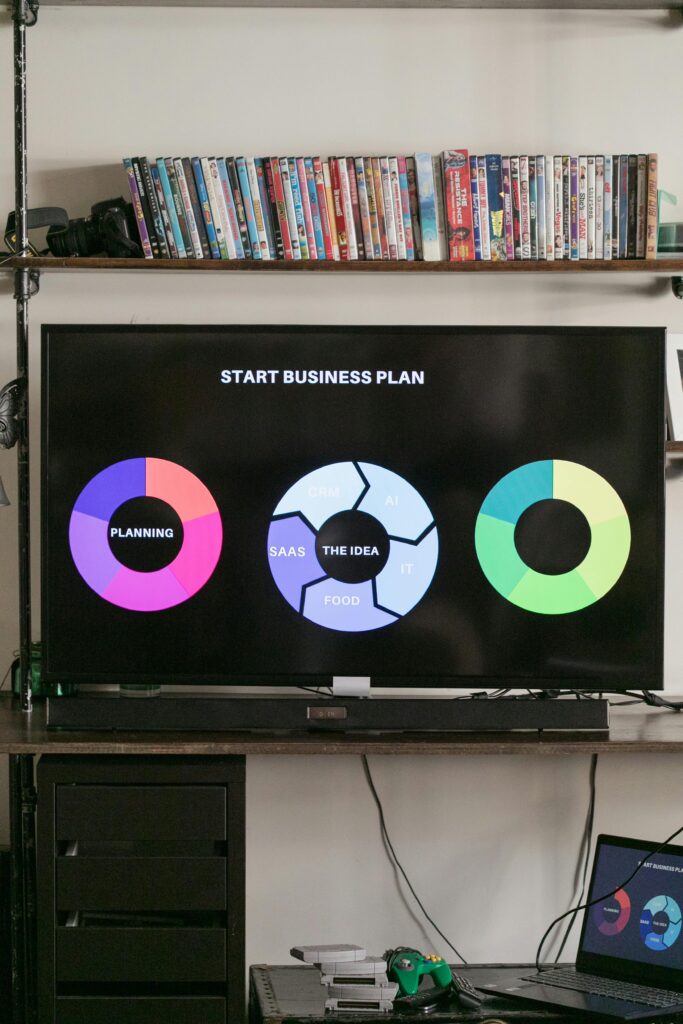
If you’re part of a B2B SaaS startup and wondering how to develop a content strategy that not only captures attention but also drives growth, you’re in the right place.
In this post, we’ll break down the essential steps for creating a winning content strategy that resonates with your audience and achieves your business goals.
Understand the Basics
Before we get into the details, let’s clarify what a content strategy is.
Simply put, it’s a plan that outlines how your business will use content to achieve its objectives. This could be anything from driving traffic to your website, generating leads, or nurturing existing customers.
For B2B SaaS startups, a solid content strategy is crucial. Why? Because it helps you build trust with your audience, showcase your expertise, and ultimately convert prospects into loyal customers.
With the right strategy, you can position your brand as a thought leader in the industry, making it easier to attract and retain customers.
Step 1: Define Your Goals
The first step in crafting a content strategy is to define your goals. What do you want to achieve with your content? Here are a few common goals for B2B SaaS startups:
Brand Awareness
Building brand awareness is essential, especially for new startups. You want potential customers to recognize and remember your brand. The more familiar they are with you, the more likely they are to consider your product when they need a solution.
Action Steps:
– Use social media platforms to share valuable insights related to your industry.
– Create engaging blog posts that answer common questions in your niche.
Lead Generation
Generating leads is often at the forefront of many startups’ goals. High-quality leads can significantly increase your chances of converting prospects into paying customers.
Action Steps:
– Develop lead magnets, such as e-books or whitepapers, that provide in-depth information in exchange for contact information.
– Use landing pages optimized for conversions to capture leads effectively.
Customer Retention
Keeping your existing customers engaged is just as important as attracting new ones. A high customer retention rate means your clients are satisfied and see value in your product.
Action Steps:
– Produce content that educates users on getting the most out of your software, such as tutorials or best practice guides.
– Regularly communicate with customers through newsletters to keep them informed about updates and new features.
Once you’ve identified your primary goals, you can tailor your content to meet them. Remember, it’s not just about creating content for the sake of it; each piece should serve a purpose.

Step 2: Know Your Audience
Understanding who your audience is a critical component of creating a successful content strategy. Knowing your audience allows you to create content that resonates with them, addresses their pain points, and ultimately drives engagement. Here’s how to get started:
Create Buyer Personas
Buyer personas are fictional representations of your ideal customers. These personas should encompass various attributes, including demographics, job roles, challenges, and motivations.
Action Steps:
– Gather data from your existing customer base to identify common characteristics.
– Conduct interviews or surveys to dive deeper into their pain points and needs.
Example: If you’re targeting marketing managers in the SaaS space, your persona might include information about their daily challenges, such as budget constraints or the pressure to demonstrate ROI from marketing efforts.
Conduct Market Research
Market research is another essential step in understanding your audience. This involves gathering data about industry trends, competitor strategies, and customer behaviors.
Action Steps:
– Use tools like Google Trends or social listening tools to monitor industry conversations.
– Analyze competitor content to see what resonates with their audience.
By combining buyer personas with market research, you can create content that speaks directly to your audience’s needs and preferences.

Step 3: Content Types and Formats
Now that you know your goals and audience, it’s time to decide what types of content you’ll create. Different formats work better for different goals, so it’s crucial to choose wisely. Here are some popular content formats that work well for B2B SaaS:
Blog Posts
Blogging is one of the most effective ways to drive traffic to your site and establish authority in your industry. Regularly publishing valuable, informative content can help improve your SEO and keep your audience engaged.
Action Steps:
– Identify relevant topics that address your audience’s pain points.
– Use a consistent posting schedule to keep your audience coming back for more.
Example: A SaaS company specializing in project management tools might write a blog post titled, “10 Tips for Streamlining Your Team’s Workflow,” providing actionable insights for their audience.
Whitepapers and E-books
In-depth resources like whitepapers and e-books can be used as lead magnets. They allow you to provide substantial value while capturing leads in return.
Action Steps:
– Choose topics that showcase your expertise and align with your audience’s interests.
– Design visually appealing documents that are easy to read and share. Example: A cybersecurity SaaS company might create an e-book titled, “The Ultimate Guide to Securing Your SaaS Application,” which potential customers can download in exchange for their email addresses.
Case Studies
Case studies showcase how your product has helped specific clients achieve results. This builds credibility and demonstrates the real-world value of your offering.
Action Steps:
- Collaborate with satisfied customers to gather data and testimonials.
- Highlight specific challenges, solutions, and measurable outcomes.
Example: A marketing automation platform could publish a case study on how a client increased lead conversion rates by 30% using their tools.
Webinars
Webinars allow you to engage directly with your audience while showcasing your expertise. They can also serve as an interactive platform for addressing audience questions.
Action Steps:
- Choose topics that are timely and relevant to your audience.
- Promote your webinars across social media and email newsletters to attract attendees.
Videos
Short, informative videos can capture attention quickly and are easily shareable on social media. Video content can help simplify complex topics and make them more digestible.
Action Steps:
- Create tutorial videos or product demos to showcase how your software works.
- Consider live streaming Q&A sessions to engage with your audience in real time.
Example: A cybers a content calendar will help you stay organized and ensure that you’re consistently delivering valuable content. Here’s how to develop an effective content calendar:
Step 4: Develop a Content Calendar
Creating a content calendar will help you stay organized and ensure that you’re consistently delivering valuable content. Here’s how to develop an effective content calendar:
Plan Ahead
Decide how often you want to publish new content. Consistency is key, whether you opt for weekly, bi-weekly, or monthly posts.
Action Steps:
– Use tools like Trello, Asana, or Google Sheets to organize your calendar.
– Include deadlines for each piece of content, from brainstorming to publication.
Mix It Up
Variety keeps your audience engaged. You can alternate between different types of content to maintain interest and appeal to various segments of your audience.
Action Steps:
– Schedule blog posts, case studies, webinars, and other formats to create a balanced mix.
– Ensure you align content types with your goals—for instance, lead magnets can be timed with product launches.
Align with Key Dates
Incorporating industry events, holidays, or product launches into your calendar can help you capitalize on timely topics and maximize engagement.
Action Steps:
– Research relevant events in your industry and plan content around them.
– Consider seasonal trends that might impact your audience’s interests.

Step 5: Optimize for SEO
Search engine optimization (SEO) is essential for driving organic traffic to your content. Here are some steps to ensure your content is optimized effectively:
Keyword Research
Identify relevant keywords that your audience is searching for. Keywords are essential for improving your content’s visibility in search engines. These are the exact words your customers type on their search engines to look for your products
Action Steps:
– Use tools like Google Keyword Planner, SEMrush, or Ahrefs to identify keywords with high search volume and low competition.
– Focus on long-tail keywords, which often have higher conversion rates due to their specificity.
On-Page SEO
On-page SEO involves optimizing individual web pages to rank higher and earn more relevant traffic. This includes elements like title tags, meta descriptions, headers, and internal linking.
Action Steps:
– Include your primary keyword in the title, headers, and throughout the content. However, write for humans first—make sure the text flows naturally.
– Write compelling meta descriptions that encourage clicks from search results.
Internal Linking
Linking to other relevant content on your site helps improve user experience and keeps visitors engaged longer. It also signals to search engines that your site has valuable, interconnected information.
Action Steps:
– Strategically link to related blog posts or resources within your content.
– Ensure that your internal links are relevant and enhance the reader’s understanding of the topic.
Step 6: Promote Your Content
Creating great content is only half the battle; you also need to promote it effectively. Here are some strategies to get your content in front of your target audience:
Social Media
Social media platforms are powerful tools for distributing your content. Use them to share your latest posts, engage with your audience, and drive traffic to your site.
Action Steps:
– Choose platforms where your audience is most active (e.g., LinkedIn for B2B).
– Create eye-catching visuals and compelling captions to encourage shares and engagement.
Email Marketing
Your email list is a valuable asset. Use it to notify subscribers about new content and keep them engaged with regular updates.
Action Steps:
– Create a monthly newsletter highlighting your latest blog posts, industry insights, and upcoming webinars.
– Segment your email list to tailor messages to specific audience groups.
Partnerships
Collaborating with other businesses or influencers in your industry can widen your reach. Guest posting on each other’s platforms can help you attract new audiences.
Action Steps:
– Identify potential partners who share a similar target audience but are not direct competitors.
– Propose mutually beneficial collaborations, such
as guest blogs, joint webinars, or social media takeovers.
Step 7: Measure and Adjust
Finally, it’s crucial to measure the effectiveness of your content strategy. Here’s how to do that:
Set KPIs
Key Performance Indicators (KPIs) are measurable values that demonstrate how effectively you are achieving your content goals. They help you assess success and make data-driven decisions.
Action Steps:
– Identify KPIs that align with your goals, such as website traffic, lead generation, or engagement rates.
– Examples of KPIs include:
– Website Traffic: Track the number of visitors to your content.
– Conversion Rates: Measure the percentage of visitors who take desired actions, such as signing up for a newsletter.
– Engagement Metrics: Analyze likes, shares, comments, and time spent on the page.
Use Analytics Tools
Analytics tools provide valuable data on how your content is performing. Google Analytics, social media insights, and other tools can help you track key metrics.
Action Steps:
– Regularly review your analytics to identify trends and insights.
– Look for patterns, such as which types of content are driving the most traffic or leads.
keep on
Content marketing is an ongoing process. Use the data you gather to adjust your strategy as needed. If certain topics resonate more with your audience, create more content around those themes.
Action Steps:
– Hold regular reviews of your content performance to identify what’s working and what’s not.
– Be flexible and willing to pivot your strategy based on insights.

Conclusion
To build a winning content strategy for your B2B SaaS startup doesn’t have to be daunting. Define your goals, understand your audience, and create valuable, optimized content, so as effectively engage potential customers and drive growth.
Content marketing is a marathon, not a sprint. It takes time to see results, but with persistence and adaptability, you can establish your brand as a trusted authority in your industry.